The Lenovo ThinkPad A285 (12.5-Inch) Review: Ryzen Pro Gets Down to Business
by Brett Howse on December 18, 2018 8:00 AM EST- Posted in
- Laptops
- AMD
- Lenovo
- ThinkPad
- Vega
- Ryzen
- Ryzen PRO
- Ryzen Mobile
- Vega Mobile
System Performance
The Lenovo ThinkPad A285 comes with the AMD Ryzen 5 Pro 2500U processor, which offers four cores, eight threads, and a base/boost frequency of 2.0 GHz / 3.6 GHz. It’s 200 MHz less than the 2700U model on both the base and boost frequency. AMD only supports DDR4 RAM – neither LPDDR3 or LPDDR4 are supported – and as such Lenovo offers 8 GB of DDR4 in a dual-channel configuration, but with no upgrade options available on the US website. It would be nice to see a 16 GB offering, but for office tasks, 8 GB should suffice. The storage offerings are 256 or 512 GB SSDs.
The big difference between the Ryzen 5 and Ryzen 7 APUs is in the GPU, where Ryzen 7 gets Vega 10, and Ryzen 5 loses two GPU cores and some clockspeed headroom, giving us Vega 8.
To compare performance, the ThinkPad A285 was run through our standard testing suite, and comparisons are of other similar devices. Of note, the Acer Swift 3 that we tested has the Ryzen 7 2700U, and just in case you’re wondering how the A285 stacks up against an older dual-core laptop, we’ve also included the ThinkPad X1 Yoga from a couple of years ago, with the Core i7-6500U. If you’d like to compare the Thinkpad A285 to any other device we’ve tested, please check out our online bench.
PCMark
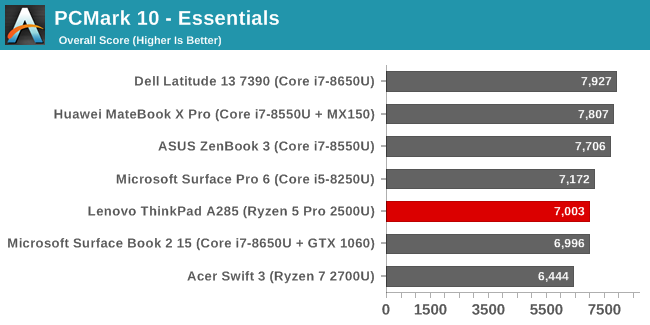



UL Benchmark’s PCMark 10 is the latest version of their industry standard set of tests, updated for Windows 10 with new workloads. It tests a wide range of tasks from productivity to digital media creation.
The ThinkPad A285 is middle of the pack, especially in the productivity results. The Ryzen 5 Pro holds its own here, and if compared to the only Core i5 device in the list, the Surface Pro 6, it is generally neck and neck with it.
Cinebench

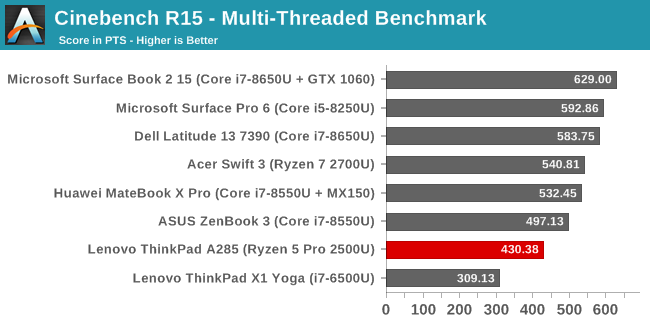
Cinebench is a purely CPU test, and it can be run as both a single-threaded or multi-threaded workload, which makes it a nice way to take a quick look at the single-threaded performance of a modern CPU, and how well that performance scales to multiple cores and threads. AMD’s single-threaded performance is not quite up to par with the fastest Core i7 models, and the Ryzen 5 Pro in the ThinkPad A285 is near the bottom in both results. With just a 200 Mhz deficit to the Ryzen 7 2700U in the Acer Swift 3, it is just barely behind it in the single-threaded test, but on the mult-threaded variant it falls farther behind.
x264
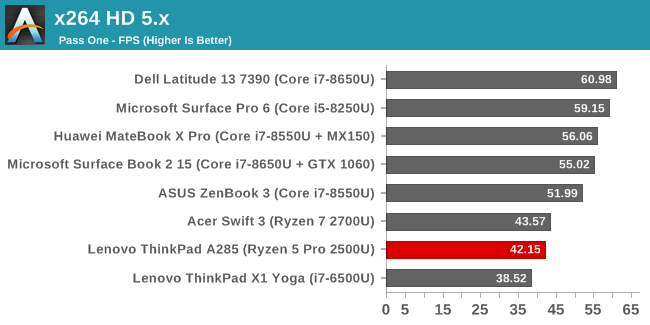

Another CPU test is x264, which converts a 1080p video using the x264 codec, and like Cinebench it loves lots of cores and high frequencies. The Thinkpad A285 is at the bottom of this result compared to other modern devices, but with the extra threads and cores, it is well above the Skylake powered ThinkPad X1 Yoga.
Web Tests
Web tests are important because clearly the web is a fundamental part of computing now, but it’s also difficult to compare devices due to the sizeable impact the browser’s scripting and rendering engines can have. Browsers continue to get updated as well, so our results are a snapshot in time.
For all of our testing, we leverage Microsoft Edge to keep that part of the equation normalized as much as possible, although Edge is updated with every feature update of Windows as well.
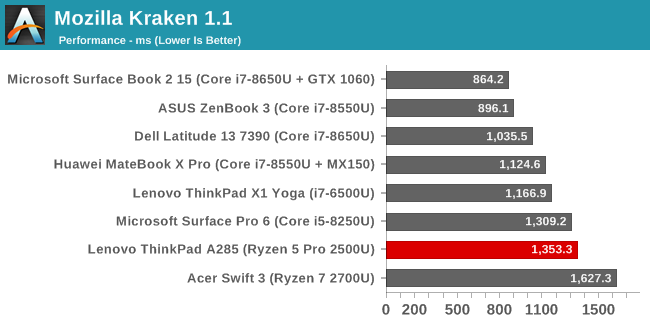
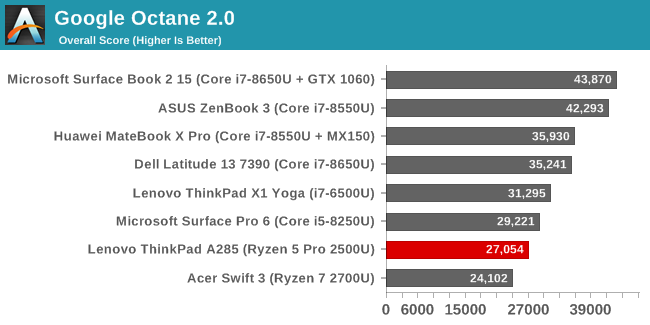
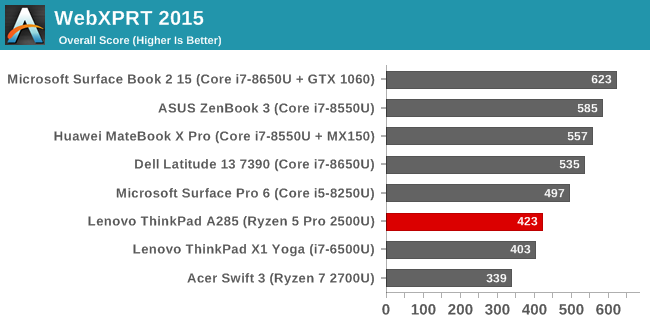
With just a 3.6 Ghz boost frequency, the Ryzen 5 Pro can’t quite match the Intel devices on any of our web tests, and Intel has worked hard to improve its frequency ramp-up speed as well which pays dividends here where workloads tend to be short. It’s very interesting to see just how far the performance has come since we tested the Ryzen 7 2700U in the Acer Swift 3 though, with the slower Ryzen 5 Pro in the ThinkPad A285 trouncing it.
Storage Performance
Lenovo offers both a 256 and 512 GB SSD in the A285, and the review unit ships with the larger one, which will have better performance than the smaller version.
The SSD in the laptop is Lenovo-branded LENSE30512GMSP34MEAT3TA, which appears to have been produced by fellow Chinese firm Ramaxel. Since SSDs tend to be mult-sourced these days, there’s no guarantee this will be in every unit shipped.
This is an NVMe drive though, and as such offers great read speeds capping out the x4 PCIe interface. Write speeds are much lower thanks to the NAND which is almost certainly TLC.
Overall, despite this SSD not being a well-known model, the performance is still more than adequate for office tasks.


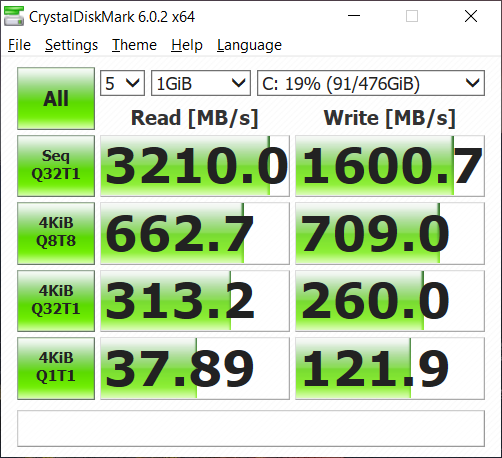








72 Comments
View All Comments
jardows2 - Tuesday, December 18, 2018 - link
This chassis is not too thin for an Ethernet port. Our organization just ordered in a bunch of HP probook 450's that are every bit as thin as this, and they all include an Ethernet port. To make Ethernet connectivity a dongle is just a stupid business decision made by Lenovo for this class of laptop.HStewart - Tuesday, December 18, 2018 - link
It not that thin of notebook, it include Type-A USB so it still fat notebook - I would think it possible to include ethernet at back part of it - probably a cost saving measure - just like the display.IGTrading - Tuesday, December 18, 2018 - link
I find it ridiculous that the reviewers felt the unexplained need of including 15" laptops and notebooks with a discrete video card and compared them with a 12.5" Thin&Light portable without a discrete GPU.Why the heck are we comparing plums to grapes and apples to pineapples ?!
The most basic journalistic "rules" for an initial review are to compare products priced similarly and of course, products with comparable specifications.
Does anybody care to compare a Lamborghini to a Ford K ? Sure those are both cars, both use petrol and both have 4 wheels ... but really !?!
You want to have an expert comparison between similar products from DIFFERENT product lines .... to show just how much extra performance does a larger chassis bring ... or a higher price ... ok, do it and present it as such.
Here's a 12" ThinkPad with X CPU vs a 15" ThinkPad with the same X CPU (or similar) and here is the extra performance the larger and more expensive product gets you.
But why the heck would you compare a 15" Microsoft Surface 2 with a discrete GPU costing 2300 USD with a 12.5" ThinkPad with just an APU (no discrete GPU) costing half the price ?!?!
Is this to bury the good test results of Lenovo's AMD-based ThinkPad and make it look mediocre ?!
If Ford launches a new Ford K ... what kind of reviewer will compare it and test it against the newest Ferrari ?!
This is being forced (on all reviewers) by Intel's PR team. You either do it, or next time you have ZERO access to anything Intel-related. (happened to me too, many years ago)
nico_mach - Tuesday, December 18, 2018 - link
It doesn't seem to have a great analogue in these numbers, true. But it is very close to the Surface Pro i5 results, which is much thinner and lighter, so it still doesn't look good. Unfortunately, the prices aren't listed in these performance results - so the dGPU and i7 that look so good aren't really in the same league, but we don't know by how much.The results are unfortunate, but this is still progress by AMD, considering where they were 2 years ago. And getting Intel to respond the way they have - buying AMD graphics, matching their core counts, moving on with a hybrid 10nm scheme - really shows how competitive they've become. And when was the last time Intel had to resort to dirty tricks? Unfortunately I think both Intel and AMD should worry more about Quallcomm and Apple than each other. This comparison is ultimately irrelevant.
DanNeely - Tuesday, December 18, 2018 - link
Adding the 1060 was arguably gratuitous; but all the fanboiing on the Ryzen mobile had been about how it was going to crush the competition so Intel's mainstream parts and NVidia's entry level MX150 are entirely appropriate. And Lenovo's performance here is just awful. With 8 clusters of GPU cores instead of 10 it should be able to do at least 80% of the performance of the 15W Ryzen 7 in the Swift 3 (and a bit closer should be expected since it can use its TDP to clock the GOU higher); but instead it's coming in around 2/3rds.StevoLincolnite - Tuesday, December 18, 2018 - link
There is allot of issues in regards to Ryzen mobile, drivers and TDP.In some instances, limiting the CPU will allow the GPU in the 2500u to run faster than the 2700u.
I have the Lenovo E585 myself with a Ryzen 2700u. - It does Overwatch, 60fps, 1080P at 56% scaling all settings low.
The driver situations is certainly bullshit though, my notebooks drivers are months out of date... AMD doesn't offer any newer revision... And if I "work around" the drivers and install unofficial ones, windows update will override it at a later date and downgrade them.
I honestly expected more out of it... Going to upgrade the Ram to 16GB with lower latencies and hope that might make a small difference. My next notebook will certainly have a discreet GPU.
IGTrading - Wednesday, December 19, 2018 - link
Yes, the mobile driver for Ryzen needs work and needs it quick. If OEMs don't give a crap about their customers and offer no decent support, AMD should step in with a Beta mobile driver. Doesn't need to be WHQL, doesn't need anything special ... just offer it.As for testing in exactly the same conditions, HP x360 has Ryzen and Intel models in the same chassis. When tested these two, AMD Ryzen trounced the Intel model.
Hul8 - Tuesday, December 18, 2018 - link
It's helpful to have the *one* token example with a discrete GPU, so readers can tell how much you give up by going integrated. Otherwise the review would be in a bubble of similarly handicapped systems.HStewart - Tuesday, December 18, 2018 - link
My comment was nothing about Intel - your response falsely assume it was.Most notebook users use notebook for word processing, spreadsheets and such and don't need descret CPU.
What does the GPU matter in comment about USB Size? I had to look up the specs to see what specs it had - is Vega 8 even descrete GPU? it not part of discussion - just falsely assume it was bias statement.
MonkeyPaw - Tuesday, December 18, 2018 - link
I agree when it comes to some of the performance tests. The dGPU model really skews the graphs by being so much better than iGPU models. Makes a comparison of similar models harder to do.